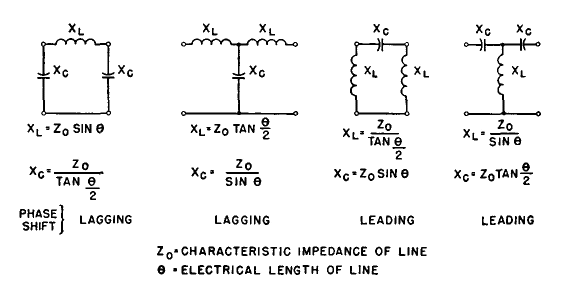| Electronic Transformers and Circuits is a free introductory textbook on transformers and related circuits. See the editorial for more information.... |

|

Home  Amplifier Circuits Amplifier Circuits  Artificial Lines Artificial Lines |
||||||






|
||||||
Artificial Lines
Figure 138 shows these four combinations for any electrical length θ of line section in degrees. It is assumed in this figure that the line operates at a single frequency and is terminated in a pure resistance equal in value to the line characteristic impedance Z0. Figure 139 is the vector diagram for a leading phase shift pi-section line of 90° electrical length. Proportions of L and C are somewhat different in these line sections than in wave filters.
To obtain approximately constant time delay over a range of frequencies, several constant-K low-pass filter sections may be used, each having a cut-off frequency high enough so that the phase shift is proportional to frequency. The time delay per section is then θ/2πf at any frequency in the range, and θ = 2πf√(LC), where 8 is the phase shift in radians, L is the inductance per section, and C is the capacitance per section. In Fig. 139, ER = Es. If the section were terminated in impedance higher than Z0, ER > Es. The line section is then a kind of transformer, although the ratio ER/ES varies with frequency. Ninety-degree line sections are often used at high frequencies to obtain transformation of voltage.
|
||||||
Home  Amplifier Circuits Amplifier Circuits  Artificial Lines Artificial Lines |
||||||
Last Update: 2011-02-17



